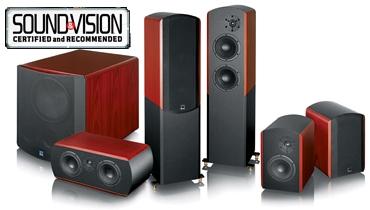SVS MTS home theater speaker system

SVS is a small but growing direct-to-Web speaker manufacturer in the unlikely location of Youngstown, Ohio. (I say "unlikely" because I'm an Eastern Snob, and we expect speaker makers to take root in places like Boston or Baltimore.) The company first earned its colors with highly affordable subwoofers that outperformed most anything in their class. But SVS has been energetically poking up into the remaining eight octaves of sound for several years now with high-value bookshelf-speaker designs.
SVS is accelerating this trend with its newest (and highest-priced) lineup to date, which consists of the MTS-01 towers, MCS-01 center, and MBS-01 surrounds. While the MBS-01s are two-way designs, the tower and center models are both "two-and-a-half ways," in which one woofer rolls off above the bottom few octaves while the other woofer's range extends all the way up to the tweeter.
Speaking of tweeters, SVS makes a pretty big deal about the one that's used in all three models. It's a new soft-dome unit from Denmark's Scanspeak, and its leading-edge features include the use of an array of six small magnets in place of the single large one found in most tweeters. This opens up the air movement, which is said to reduce unwanted reflections.
The MTS line's cabinet design is strictly conventional. This is the kind of construction that was standard 30 or 40 years ago, with solid, well-braced enclosures made from heavy wood-composite panels. Though biggish and boxy, these speakers are nonetheless handsome, nicely finished in real wood veneers and constructed with obvious care. The speakers also have some contemporary touches, like a cunning grille arrangement held in place by invisible magnets.
SVS rounded out the system by sending its flagship subwoofer, the PB-13 Ultra - and I still haven't forgiven them. Uncrating and moving this 150-pound behemoth - literally the size of a small four-burner range - was no light undertaking. But the results were worth the effort.
SETUP
I unpacked the boxes, muscled the speakers into place, and connected them. All three MTS models feature dual-linked multiway terminals and come with both soft- and hard-cone feet.
Each speaker has a tweeter-level switch with 0 and -3-dB settings, which I left at -3 for a subtle but noticeable reduction in treble energy. Each one also comes with a cylindrical soft-foam "bung" for plugging each cabinet port so you can convert the speaker design from bass-reflex (vented) to more-or-less sealed. Since the MTS-01 and the MCS-01 both have dual ports, you can re-tune them by leaving one port plugged and one open.
I spent quite a bit of time experimenting with the various bunging combinations, and found that each one yielded a meaningful difference. (SVS obligingly graphs several examples in the owner's manuals.) To cut a long story short: My room has a modest but well-established 50-Hz rise, so when the tower speakers were running full-range, they sounded tighter and more transparent when fully bunged. Meanwhile, the center speaker best matched its mates when single-bunged. Bunging really didn't matter with the MBS-01 surrounds since the signal to those speakers was crossed over to limit bass reproduction.
- Log in or register to post comments




































































